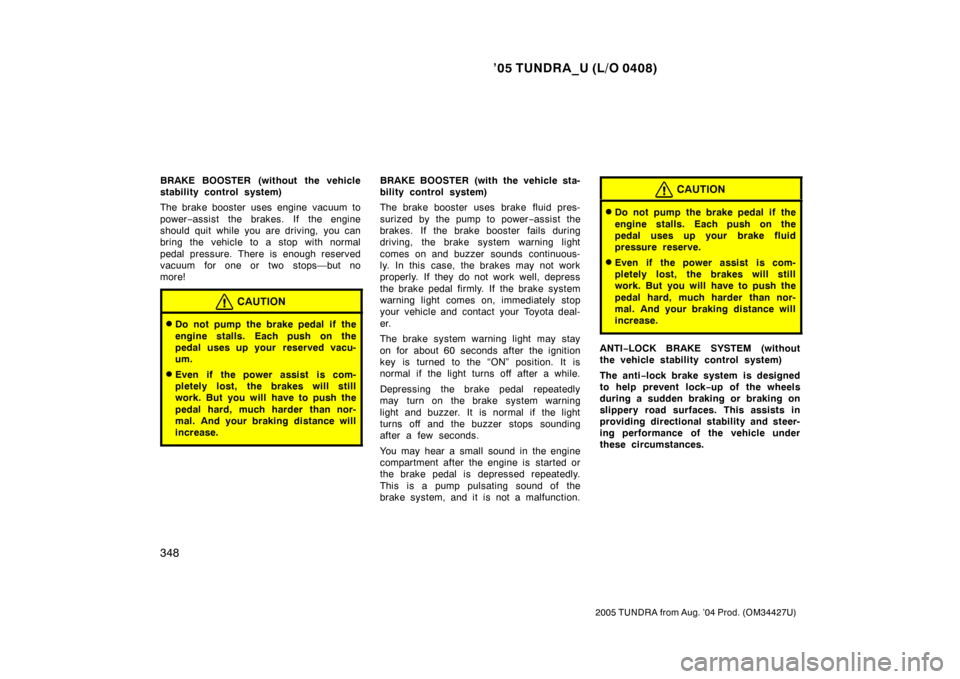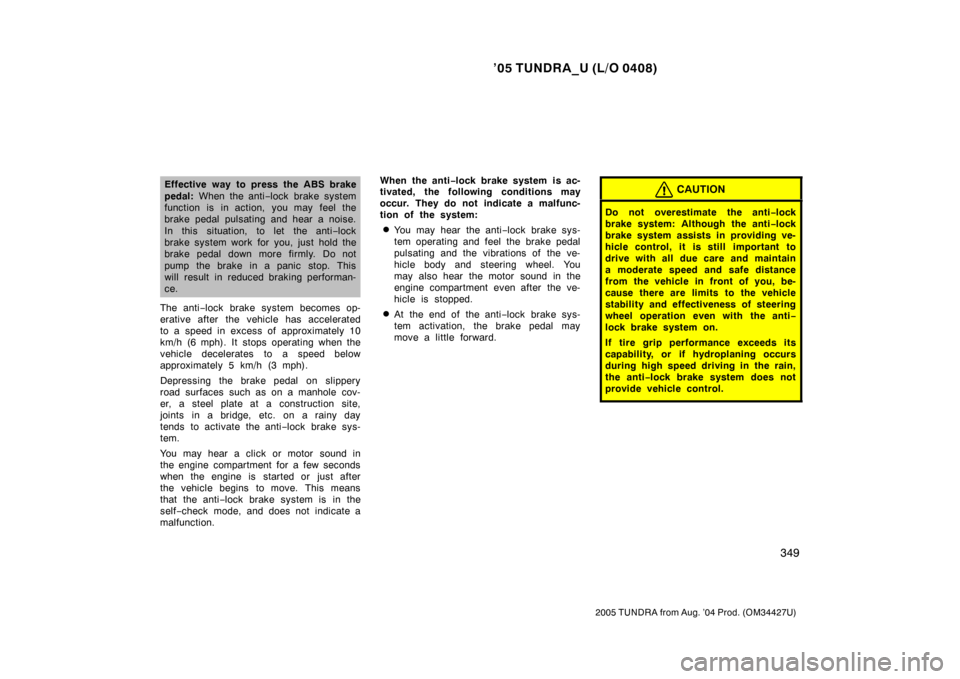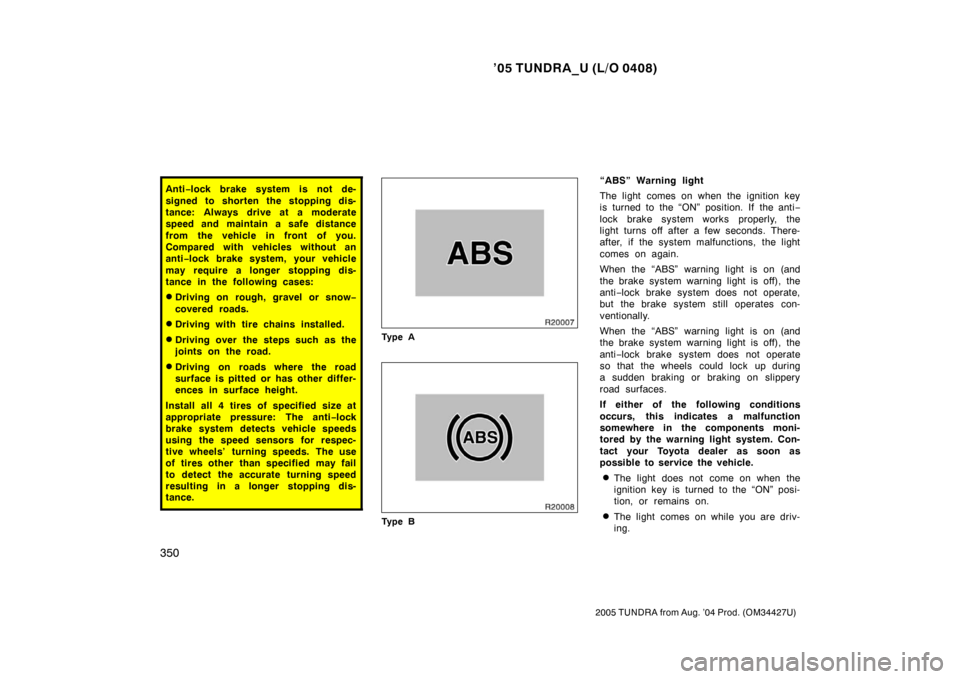Page 343 of 506
’05 TUNDRA_U (L/O 0408)
332
2005 TUNDRA from Aug. ’04 Prod. (OM34427U)
The rear console box is equipped with
compact disc and cassette tape holders.
To use the holders, raise the console box
lid and upper tray by pulling up the lock
release lever.
The plates for the compact disc and cas-
sette tape holders are detachable.
Compact disc and cassette
tape holder (type A) Compact disc and cassette
tape holder (type B)
Page 344 of 506
’05 TUNDRA_U (L/O 0408)
333
2005 TUNDRA from Aug. ’04 Prod. (OM34427U)
The rear console box is equipped with
a compact disc and cassette tape hold-
er.
To use the holder, raise the console box
lid by pulling up the lock release lever.
The compact disc and cassette tape hold-
er is detachable.The auxiliary box is equipped with a
cassette tape holder.
To use the holder, raise the auxiliary box
lid while pushing the lock release button.
The plate for the cassette tape holder is
detachable.
Cassette tape holder
Page 347 of 506
’05 TUNDRA_U (L/O 0408)
336
2005 TUNDRA from Aug. ’04 Prod. (OM34427U)
The rear console box is equipped with
a note pad holder. This is designed to
hold small paper such as note pads.
To use the holder, raise the console box
upper lid while pushing the lock release
button.
CAUTION
�Do not write on the note pad holder
while the vehicle is moving.
�Do not place anything else on the
note pad holder. Such items may be
thrown about in the compartment
and possibly cause injury during
sudden braking or an accident.
�To reduce the chance of injury in
case of an accident or a sudden
stop while driving, keep the console
box upper lid closed when it is not
in use.
Grocery bag hooks
Cargo net hooks
Note pad holder Grocery bag/cargo net hooks
Page 348 of 506
’05 TUNDRA_U (L/O 0408)
337
2005 TUNDRA from Aug. ’04 Prod. (OM34427U)
These hooks are designed to hang
things like grocery bags or cargo net.
Although the cargo net itself is not in-
cluded as an original equipment, these
hooks can be used to hang the cargo net.
NOTICE
�To prevent damage to the hooks,
avoid hanging heavy loads on them
when using them as grocery bag
hooks.
� To prevent damage to the hook,
avoid hanging things other than a
cargo net on it when using them as
cargo net hooks.
Use a floor mat of the correct size.
If the floor carpet and floor mat have a
hole, then it is designed for use with a
locking clip. Fix the floor mat with locking
clip into the hole in the floor carpet.CAUTION
Make sure the floor mat is properly
placed on the floor carpet. If the floor
mat slips and interferes with the
movement of the pedals during driv-
ing, it may cause an accident.
Floor mat
Page 354 of 506

’05 TUNDRA_U (L/O 0408)
343
2005 TUNDRA from Aug. ’04 Prod. (OM34427U)
GASOLINE CONTAINING MMT
Some gasoline contain an octane en-
hancing additive called MMT (Methylcy-
clopentadienyl Manganese Tricarbonyl).
Toyota does not recommend the use of
gasoline that contains MMT. If fuel con-
taining MMT is used, your emission con-
trol system may be adversely affected.
The Malfunction Indicator Lamp on the in-
strument cluster may come on. If this hap-
pens, contact your Toyota dealer for ser-
vice.
GASOLINE QUALITY
In a very few cases, you may experience
driveability problems caused by the partic-
ular gasoline that you are using. If you
continue to have unacceptable driveability,
try changing gasoline brands. If this does
not rectify your problem, then consult your
Toyota dealer.NOTICE
�Do not use gasohol other than
stated above. It will cause fuel sys-
tem damage or vehicle performance
problems.
� If driveab ility problems occur ( poor
hot starting, vaporizing, engine
knock, etc.), discontinue the use.
� Take care not to spill gasohol dur-
ing refueling. Gasohol may cause
paint damage.
FUEL TANK CAPACITY
100 L (26.4 gal., 22.0 Imp. gal.) The fuel pump shut off system stops sup-
plying fuel to the engine to minimize the
risk of fuel leakage when the engine stalls
or an airbag inflates upon collision. To
restart the engine after the fuel pump shut
off system activates, turn the ignition
switch to “ACC” or “LOCK” once and start
it.
CAUTION
Inspect the ground under the vehicle
before restarting the engine. If you
find that liquid has leaked onto the
ground, it is the fuel system has
been damaged and it is in need of
repair. In this case, do not restart the
engine.
Fuel pump shut off system
Page 359 of 506

’05 TUNDRA_U (L/O 0408)
348
2005 TUNDRA from Aug. ’04 Prod. (OM34427U)
BRAKE BOOSTER (without the vehicle
stability control system)
The brake booster uses engine vacuum to
power−assist the brakes. If the engine
should quit while you are driving, you can
bring the vehicle to a stop with normal
pedal pressure. There is enough reserved
vacuum for one or two stops—but no
more!
CAUTION
�Do not pump the brake pedal if the
engine stalls. Each push on the
pedal uses up your reserved vacu-
um.
�Even if the power assist is com-
pletely lost, the brakes will still
work. But you will have to push the
pedal hard, much harder than nor-
mal. And your braking distance will
increase.
BRAKE BOOSTER (with the vehicle sta-
bility control system)
The brake booster uses brake fluid pres-
surized by the pump to power −assist the
brakes. If the brake booster fails during
driving, the brake system warning light
comes on and buzzer sounds continuous-
ly. In this case, the brakes may not work
properly. If they do not work well, depress
the brake pedal firmly. If the brake system
warning light comes on, immediately stop
your vehicle and contact your Toyota deal-
er.
The brake system warning light may stay
on for about 60 seconds after the ignition
key is turned to the “ON” position. It is
normal if the light turns off after a while.
Depressing the brake pedal repeatedly
may turn on the brake system warning
light and buzzer. It is normal if the light
turns off and the buzzer stops sounding
after a few seconds.
You may hear a small sound in the engine
compartment after the engine is started or
the brake pedal is depressed repeatedly.
This is a pump pulsating sound of the
brake system, and it is not a malfunction.CAUTION
�Do not pump the brake pedal if the
engine stalls. Each push on the
pedal uses up your brake fluid
pressure reserve.
�Even if the power assist is com-
pletely lost, the brakes will still
work. But you will have to push the
pedal hard, much harder than nor-
mal. And your braking distance will
increase.
ANTI −LOCK BRAKE SYSTEM (without
the vehicle stability control system)
The anti −lock brake system is designed
to help prevent lock− up of the wheels
during a sudden braking or braking on
slippery road surfaces. This assists in
providing directional stability and steer-
ing performance of the vehicle under
these circumstances.
Page 360 of 506

’05 TUNDRA_U (L/O 0408)
349
2005 TUNDRA from Aug. ’04 Prod. (OM34427U)
Effective way to press the ABS brake
pedal: When the anti −lock brake system
function is in action, you may feel the
brake pedal pulsating and hear a noise.
In this situation, to let the anti −lock
brake system work for you, just hold the
brake pedal down more firmly. Do not
pump the brake in a panic stop. This
will result in reduced braking performan-
ce.
The anti −lock brake system becomes op-
erative after the vehicle has accelerated
to a speed in excess of approximately 10
km/h (6 mph). It stops operating when the
vehicle decelerates to a speed below
approximately 5 km/h (3 mph).
Depressing the brake pedal on slippery
road surfaces such as on a manhole cov-
er, a steel plate at a construction site,
joints in a bridge, etc. on a rainy day
tends to activate the anti −lock brake sys-
tem.
You may hear a click or motor sound in
the engine compartment for a few seconds
when the engine is started or just after
the vehicle begins to move. This means
that the anti −lock brake system is in the
self −check mode, and does not indicate a
malfunction. When the anti
−lock brake system is ac-
tivated, the following conditions may
occur. They do not indicate a malfunc-
tion of the system:
�You may hear the anti −lock brake sys-
tem operating and feel the brake pedal
pulsating and the vibrations of the ve-
hicle body and steering wheel. You
may also hear the motor sound in the
engine compartment even after the ve-
hicle is stopped.
�At the end of the anti −lock brake sys-
tem activation, the brake pedal may
move a little forward.
CAUTION
Do not overestimate the anti −lock
brake system: Although the anti −lock
brake system assists in providing ve-
hicle control, it is still important to
drive with all due care and maintain
a moderate speed and safe distance
from the vehicle in front of you, be-
cause there are limits to the vehicle
stability and effectiveness of steering
wheel operation even with the anti −
lock brake system on.
If tire grip performance exceeds its
capability, or if hydroplaning occurs
during high speed driving in the rain,
the anti −lock brake system does not
provide vehicle control.
Page 361 of 506

’05 TUNDRA_U (L/O 0408)
350
2005 TUNDRA from Aug. ’04 Prod. (OM34427U)
Anti−lock brake system is not de-
signed to shorten the stopping dis-
tance: Always drive at a moderate
speed and maintain a safe distance
from the vehicle in front of you.
Compared with vehicles without an
anti −lock brake system, your vehicle
may require a longer stopping dis-
tance in the following cases:
�Driving on rough, gravel or snow−
covered roads.
�Driving with tire chains installed.
�Driving over the steps such as the
joints on the road.
�Driving on roads where the road
surface is pitted or has other differ-
ences in surface height.
Install all 4 tires of specified size at
appropriate pressure: The anti −lock
brake system detects vehicle speeds
using the speed sensors for respec-
tive wheels’ turning speeds. The use
of tires other than specified may fail
to detect the accurate turning speed
resulting in a longer stopping dis-
tance.
Ty p e A
Ty p e B
“ABS” Warning light
The light comes on when the ignition key
is turned to the “ON” position. If the anti −
lock brake system works properly, the
light turns off after a few seconds. There-
after, if the system malfunctions, the light
comes on again.
When the “ABS” warning light is on (and
the brake system warning light is off), the
anti −lock brake system does not operate,
but the brake system still operates con-
ventionally.
When the “ABS” warning light is on (and
the brake system warning light is off), the
anti −lock brake system does not operate
so that the wheels could lock up during
a sudden braking or braking on slippery
road surfaces.
If either of the following conditions
occurs, this indicates a malfunction
somewhere in the components moni-
tored by the warning light system. Con-
tact your Toyota dealer as soon as
possible to service the vehicle.
�The light does not come on when the
ignition key is turned to the “ON” posi-
tion, or remains on.
�The light comes on while you are driv-
ing.